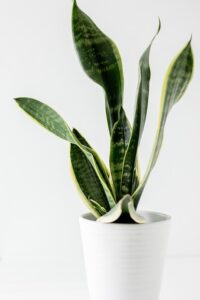Thinking about introducing new green and life into your living space?
There are a myriad of great plant species to choose from; and, to be fair, fake plants can easily lush up the environment and bring life to the room, even if just by appearance alone. But, if you truly want to spice up your living space, whether it be your house, apartment, or even college dorm, you may want to consider snake plants.
In the world of indoor plants, the snake plant (Sansevieria trifasciata) stands out not only for its elegant and resilient appearance but also for the myriad of health benefits it offers. Commonly known as the mother-in-law’s tongue or the viper’s bowstring hemp, the snake plant is not just a decorative addition to your living space; it’s a green ally that contributes to a healthier lifestyle.
Incorporating snake plants into your home may be a fantastic idea. If you’re looking to organically increase the quality of living whilst having a stylish piece that revivifies your living space, they may be quite suitable for you.
In this article, we will explore 8 reasons why incorporating snake plants into your indoor environment can positively impact your well-being. Note that some of these points may be more important for particular residents such as those with certain health conditions.
Air Purification
Snake plants are undoubtedly an air purification champion.
To start, they have an exceptional ability to purify indoor air. Like other plants, snake plants absorb carbon dioxide during the day and release oxygen through photosynthesis. However, snake plants are uniquely able to continue this process at night, making them an ideal option for bedrooms and spaces where you spend a significant amount of time.
If you find you or your child suffer from breathing conditions such as asthma or are prone to air-borne allergens, a snake plant is perfect for you. You’ll find that the nighttime process makes breathing easier for you. And, this can even help with your sleep. For people sensitive to dry air, the snake plant also releases moisture in the air which both traps allergens like dust and moisturizes the air.
For all those long-name chemicals you can’t even pronounce, snake plants got them covered. They are renowned for filtering common pollutants such as benzene, formaldehyde, trichloroethylene, xylene, and toluene. These toxins are typically found in household items like paints, cleaning products, and synthetic materials. So, by introducing snake plants into your living room, you’re doing yourself a favor by creating a healthier and cleaner indoor environment.
Enhanced Respiratory Health
In addition to releasing oxygen and purifying air, snake plants in turn positively impact respiratory health. Oxygen-rich air can reduce the risk of respiratory issues, enhance lung capacity, and promote overall well-being. For those prone to allergies or asthma, incorporating snake plants into the indoors may offer a natural, cost-effective way to mitigate your symptoms!
It’s important to remember that snake plants are a consistent benefit. That is, they’re not a one-time deal.
You place them in your living space, and they become a solid foundation for your room’s living conditions. Keeping snake plants in your room or home increases the quality of air and improves your respiratory health every time you walk in. That way, you don’t need to worry about keeping your living space properly filtered as much as you normally would. They can do the work for you.
Adding on to the previous point on air purification, the snake plant’s proficiency in reducing airborne pollutants and dust comes from its moisturizing the air. This helps to trap unnecessary particles in the atmosphere, making the room it resides in a natural purification chamber. This can help especially for people who struggle with sleep issues due to respiratory breathing problems. While conditions such as sleep apnea can be caused by other variables such as increased body fat percentage accumulating in the neck region –thereby restricting the lungs by weight– having cleaner air can still greatly benefit those who struggle with all sorts of respiratory health conditions.
Humidity Regulation
Maintaining optimal indoor humidity levels is crucial for comfort and health.
If it’s too dry, it’s harsh on the air and your lungs. Too humid isn’t good either.
Snake plants have a unique ability to regulate humidity through a process known as transpiration. They release water vapor into the air, creating a microclimate that helps balance humidity levels. This natural regulation can be particularly beneficial in dry climates or during winter months when the use of heaters tends to reduce air moisture.
So, overall, a snake plant can help with not just residents with sensitivity to allergens but many temperature/humidity sensitivities as well. It’s a great addition for those who want to make their living space comfortable and welcoming to all.
One of the best advantages to this is the moisturizing effect on the air for those who suffer from dry skin. Dry skin affects many elements of people’s lives, including but not limited to…
- cracks and peels in the skin that lead to itchiness
- leading to further problems in existing conditions such as eczema or psoriasis
- sensitivity to skin products
- sensitivity to fabrics and certain clothing
- unsightly redness
Thus, maintaining a regulated humidity level would ensure those who have dry skin can have better conditions that support their epidermal needs. Additionally, most people forget how dry skin can impact the scalp. Most people with dry scalps will suffer without properly regulated humidity levels in their rooms. Snake plants help with the humidity in the room, ensuring people maintain a healthy scalp that doesn’t dry or flake off (which is also often misdiagnosed as dandruff, a yeast-like fungus called Malassezia).
Stress reduction and improved mental health
The aesthetic appeal of snake plants goes beyond their physical appearance. Studies suggest that the presence of indoor plants, including snake plants, can have positive effects on mental health. The greenery and natural elements contribute to a calming and stress-reducing atmosphere. Whether it’s on your desk, or on top of your fridge, snake plants will surely provide a sense of tranquility and contribute to a more relaxed state of mind.
Additionally, having a ‘pet plant’ and caring for a living organism, such as watering and tending to a snake plant, can be therapeutic. It encourages mindfulness and provides a sense of purpose, fostering a connection with nature even in the midst of living in the city.
But, one of the things you may have not known is just WHY introducing plants like these can help reduce stress and improve your mental health.
According to the Biophilia Hypothesis, the human mind is “connected” on a deeper level to nature. That means exposure to diverse forms of plants and foliage like snake plants would help replicate the natural habitat and environment we humans were meant to live in to ensure naturalistic and positive mental mindsets. It ensures we’re in our “base” state and not consistently operating in an inorganic environment like that of our urbanized and modernized societies that so often leave out the much-needed green in our lives.
Improved Sleep Quality
This one is pretty straightforward.
In addition to their air-purifying capabilities, snake plants can positively influence sleep quality. As mentioned previously, snake plants continue to release oxygen at night, unlike most other plants that undergo photosynthesis only during the day. Increased oxygen levels can promote better sleep by creating a more conducive environment for relaxation and rest.
Low maintenance and durability
Again, another straightforward point.
Not all of us have a green thumb, but luckily tending to a snake plant doesn’t require one. Snake plants are known for their resilience and ability to thrive in a variety of conditions. Snake plants can tolerate low light levels and irregular watering, making them suitable for novice plant enthusiasts. Their durability makes them an excellent option for busy individuals or those who want to enjoy the benefits of indoor plants without the hassle of intensive care.
Versatility in Design
Beyond their health benefits, snake plants add a touch of elegance and versatility to interior spaces. With a plethora of varieties and sizes available, snake plants can complement a wide range of interior design styles. Whether in a minimalist, modern setting or a traditional eclectic space, the unique architectural form of snake plants enhances the visual appeal of any room.
We often recommend people use snake plants if they want the plant to stand out as a statement piece in a minimalist environment. That way, the green of the plant would be the focus and also introduce more green to the eyes, helping with mental state effectively. On the topic of minimalism, they also work well with neutral tones that are soft on the eyes. So, if you have bold and outstanding colors in your rooms, the snake plant can work well in toning down the “noise” of the room.
Remember: a well-balanced environment helps with a well-balanced mind. So, it’s crucial to ensure you’re decorating your environment in a manner that is suitable to what makes you feel mentally sound, safe, and comfortable. Plants don’t just help our living space aesthetically and physically, but also mentally!
Medicinal Purposes
While snake plants are commonly known for their aesthetic and air-purifying qualities, certain cultures have explored the potential for medicinal purposes throughout history. In traditional medicine, parts of snake plants have been used to address a myriad of health issues. The leaves are believed to contain compounds with chemical properties. Some traditional practices involve extracting the gel-like substance from the leaves and applying it topically to treat skin conditions, wounds, and minor burns. This gel is thought to possess antimicrobial and anti-inflammatory properties, which aid in the healing process.
Additionally, the snake plant has been investigated for its potential role in respiratory health. Some studies suggest that compounds found in the plant may have bronchodilator effects, potentially assisting individuals with respiratory conditions.
In addition to its topical and respiratory applications, the snake plant has been explored for its role in enhancing immune function. The plant contains various bioactive compounds, including flavonoids and tannins, which are known for their antioxidant properties. Antioxidants play a crucial role in neutralizing harmful free radicals in the body, potentially contributing to a strengthened immune system. In Indonesia, the snake plant has been traditionally esteemed for its anti-free radical properties. Research endeavors in this regard involve the isolation and purification of endophytic fungi to assess their anti-radical activity.
However, while snake plants are generally safe for humans, they contain compounds that can be toxic to pets if ingested.
While these findings are intriguing, it’s essential to note that the medicinal use of snake plants is still an area of ongoing research, and more scientific studies are needed to establish their efficacy and safety for specific health applications.
As with any herbal remedy, it is important to consult with your healthcare professionals before incorporating snake plants into a medicinal regimen, especially for those with pre-existing health conditions or those taking medications. As more research in this field progresses, snake plants could be potential contributors to alternative and complementary medicine.
Other fun facts
Cultural Folklore – In some traditions, snake plants are believed to protect against negative energy and bring good luck, making them guardians of positive vibes in addition to being houseplants. In Feng Shui, the snake plant is believed to bring positive energy and good luck to the home.
Propagates Easily – Snake plants are known for their ease of propagation. They can be grown from cuttings or divided from mature plants, making them a popular choice for those wanting to share their greenery with friends or expand their plant collection.
Underwater – Snake plants can also be submerged in water for extended periods and continue to thrive. This makes them a unique choice for aquariums and water gardens.
Conclusion
Thus, incorporating snake plants into your indoor environment is a holistic approach to promoting good health and well-being. From their air-purifying qualities and ability to regulate humidity to their positive impact on mental health and sleep quality, snake plants are much more than mere decorative elements. These green allies bring nature indoors, creating a symbiotic relationship that transforms the aesthetics of your space and your overall quality of life. Embracing the benefits of a snake plant is a simple, yet impactful step towards living a healthier and more balanced lifestyle.
















